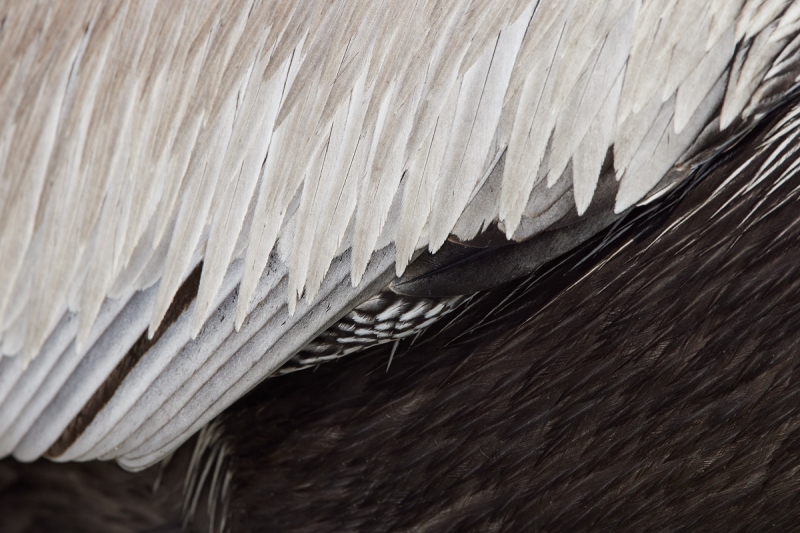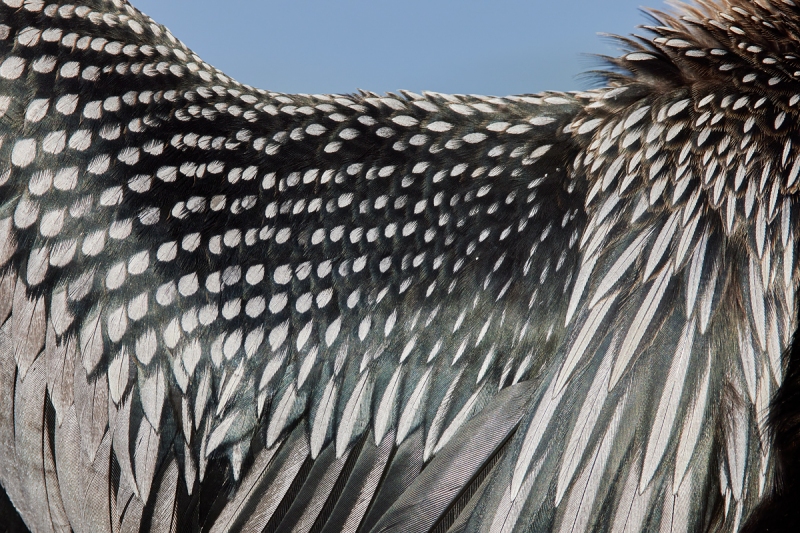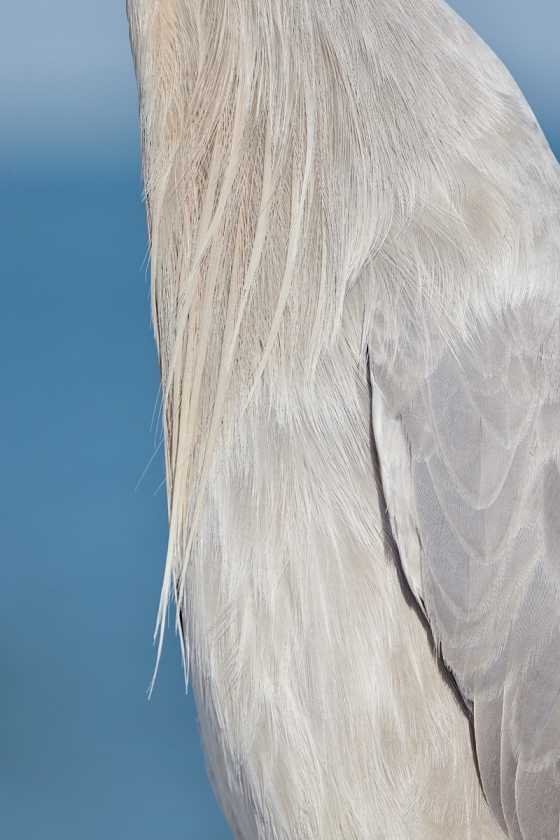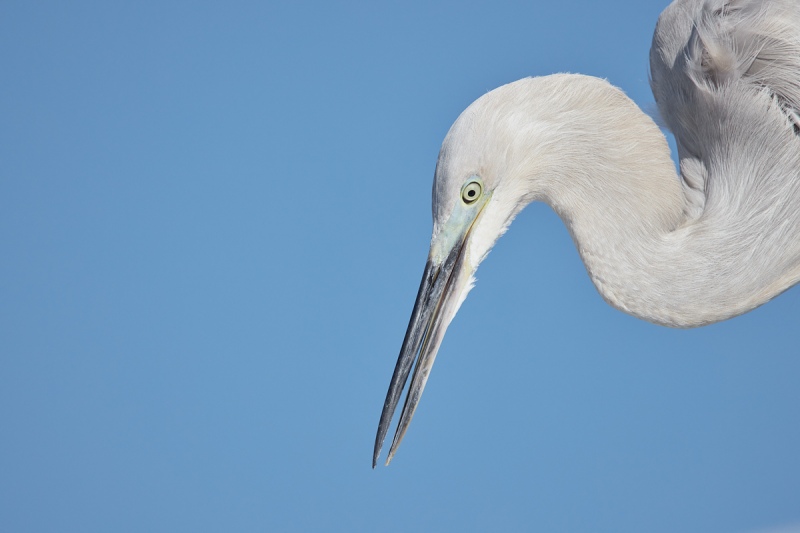Canon R6 Bodies in Stock now at Bedfords/R5 Bodies on the Way!
Steve Elkins asked me to let you know that he is receiving a good number of Canon EOS-R6 bodies today. Get yours by clicking here. Enter the BIRDSASART discount code at checkout, save 3%, and enjoy free second-day air Fed-Ex shipping. And shoot me your receipt to receive your free copy of the R5/R6 AF e-Guide and save $65.00 off the price of the R5 User’s e-Guide.
Six R5 Bodies are on the way as well …
What’s Up?
Right before I got out of my SUV to pick up and pack up the very still raccoon, I saw that about 100 or so Cattle Egrets that had been roosting on the pier railings were taking off and flying to the South Peninsula, so I pulled my vehicle up 100 yards in an effort to get some hand held flight shots from the driver’s seat. I glanced in the driver’s side mirror and saw that several vultures were feeding on the carcass. Lesson learned: my vehicle had been too close to the long-deceased raccoon.
I spent a great deal of time answering e-mails, responding to comments on yesterday’s blog post, and working on an article entitled A Personal Account: The Photographic Benefits of the COVID 19 Pandemic for the Georgia Nature Photographer Association Newsletter. After being postponed a year, I will be keynoting, speaking, and teaching at the GNPA Expo at Jekyll Island, Georgia — April 7-10, 2022.
I had a great swim in a now very warm and delightful pool. Summer has come early to central Florida. I did make it down to the lake just before sunset for a short photo session. With the wind from the southwest, I tried a new plan that did not involve birds landing directly away from me. I had a few good chances.
Today is Tuesday 2 March 2021. The forecast for ILE this morning is for mostly cloudy skies with a light north/northeast wind. I will be heading down to the lake for a bit.
Wherever you are and whatever you are doing, I hope that you have a great day.
This blog post took 1 1/2 hours to prepare and makes seventy-one days in a row with a new one. Please remember …
Please Remember
With income from IPTs now at zero, please, if you enjoy and learn from the blog, remember to use one of my two affiliate programs when purchasing new gear. Doing so just might make it possible for me to avoid having to try to get a job as a Walmart greeter and will not cost you a single penny more. And if you use Bedfords and remember to enter the BIRDSASART code at checkout, you will save 3% on every order and enjoy free second-day air shipping. In these crazy times — I am out at least forty to sixty thousand dollars so far due to COVID 19 (with lots more to come) — remembering to use my B&H link or to shop at Bedfords will help me out a ton and be greatly appreciated. Overseas folks who cannot order from the US because of import fees, duties, and taxes, are invited to help out by clicking here to leave a blog thank you gift if they see fit.
Great Topaz News!
Folks who use the BAA Topaz link to purchase Sharpen AI, DeNoise AI, or the Utility Bundle (or any other Topaz plug-ins) will receive a 15% discount by entering the ARTHUR15 code at checkout. If the stuff is on sale (as it usually is), you save 15% off of the sale price! To get the discount you must use my link and you must enter the discount code. Be sure to start with this link.
Those who purchase Sharpen AI, DeNoise AI, or any other Topaz plug-ins using my link and then entering the ARTHUR15 code at checkout can e-mail to request a short Getting Started with Topaz e-Guide. Please include a copy of your Topaz receipt that shows the discount. Aside from the basics, the guide explains how to install the plug-ins so that they appear in the Photoshop Filter Menu.
|
|
RawDigger e-Guide with Two Videos |
The RawDigger e-Guide with Two Videos
by Arthur Morris with Patrick Sparkman
The RawDigger e-Guide was created only for serious photographers who wish to get the absolute most out of their raw files.
Patrick and I began work on the guide in July 2020. At first we struggled. We asked questions. We learned about Max-G values. We puzzled as to why the Max G values for different cameras were different. IPT veteran Bart Deamer asked lots of questions that we could not answer. We got help from RawDigger creator Iliah Borg. We learned. In December, Patrick came up with an Adapted Histogram that allows us to evaluate the exposures and raw file brightness for all images created with all digital camera bodies from the last two decades. What we learned each time prompted three complete beginning to end re-writes.
The point of the guide is to teach you to truly expose to the mega-Expose-to-the-Right so that you will minimize noise, maximize image quality, best utilize your camera’s dynamic range, and attain the highest possible level of shadow detail in your RAW files in every situation. In addition, your properly exposed RAW files will contain more tonal information and feature the smoothest possible transitions between tones. And your optimized images will feature rich, accurate color.
We teach you why the GREEN channel is almost always the first to over-expose. We save you money by advising you which version of RawDigger you need. We teach you how to interpret the Max G values for your Canon, Nikon, and SONY camera bodies. It is very likely that the Shock-your-World section will shock you. And lastly — thanks to the technical and practical brilliance of Patrick Sparkman — we teach you a simple way to quickly and easily evaluate your exposures and raw file brightness using an Adapted RawDigger histogram.
The flower video takes you through a session where artie edits a folder of images in Capture One while checking the exposures and Max-G values in RawDigger. The Adapted Histogram video examines a series of recent images with the pink histograms and covers lots of fine points including and especially how to deal with specular highlights. The directions for setting up the Adapted Histogram are in the text.
If we priced this guide based on how much effort we put into it, it would sell it for $999.00. But as this guide will be purchased only by a limited number of serious photographers, we have priced it at $51.00. You can order yours here in the BAA Online Store.
Canon EOS R5 Camera User’s e-Guide
On Thursday, I sent out about a dozen copies of the almost finished Canon EOS R5 Camera User’s e-Guide for review to folks who had previously gotten free copies of the R5/R6 AF e-Guide by using my affiliate links to purchase their Canon mirrorless gear. In the same vein, I will be contacting everyone who purchased the R5/R6 AF e-Guide on Monday.
Because the camera and the Menus are so complex, this guide has required a ton of research, a lot of time, and a lot of effort (and will continue to do so until it is complete). It should be finished by the first week in March. 2021. The final update of the R5/R6 AF e-Guide has become part of the complete Camera User’s e-Guide; it will be revised if warranted.
The complete Camera User’s guide will sell for $75.00. Folks who purchased their Canon gear using my links will receive a $65.00 discount; the guide will cost them a nominal $10.00. Folks who spent more than $7500.00 on Canon mirrorless gear using either of my affiliate links (B&H or Bedfords), will receive the User’s Guide for free. Folks who purchased the R5/R6 AF e-Guide will receive a $10.00 discount on the User’s e-Guide. The best news is that the end is in sight.
New and Better Bedfords Discount Policy!
You can now save 3% on all of your Bedfords photo gear purchases by entering the BIRDSASART coupon code at checkout. Your discount will be applied to your pre-tax total. In addition, by using the code you will get 2nd day air shipping via Fed Ex.
Grab a Nikon AF-S Teleconverter TC-14E III and save $14.99. Purchase a Canon EOS R5 and your discount will be $116.97. Purchase a Sony FE 600mm f/4 GM OSS lens and save a remarkable $389.94! Your Bedford’s purchase no longer needs to be greater than $1,000.00 for you to receive a discount. The more you spend, the more you save.
Money Saving Reminder
Many have learned that if you need a hot photo item that is out of stock at B&H and would enjoy free second-day air shipping, your best bet is to click here, place an order with Bedfords, and enter the coupon code BIRDSASART at checkout. If an item is out of stock, contact Steve Elkins via e-mail or on his cell phone at (479) 381-2592 (Central time). Be sure to mention the BIRDSASART coupon code and use it for your online order to save 3% and enjoy free 2nd-day air shipping. Steve has been great at getting folks the hot items that are out of stock at B&H and everywhere else. The wait lists at the big stores can be a year or longer for the hard to get items. Steve will surely get you your gear long before that. For the past year, he has been helping BAA Blog folks get their hands on items like the SONY a9 ii, the SONY 200-600 G OSS lens, the Canon EOS R5, the Canon RF 100-500mm lens, and the Nikon 500mm PF. Steve is personable, helpful, and eager to please.


Gear Questions and Advice
Too many folks attending BAA IPTs (remember those?) and dozens of photographers whom I see in the field and on BPN, are–out of ignorance–using the wrong gear especially when it comes to tripods and more especially, tripod heads… Please know that I am always glad to answer your gear questions via e-mail. Those questions might deal with systems, camera bodies, accessories, and/or lens choices and decisions.
|
|
|
This image was created on 26 February 2021 at Fort DeSoto Park, Tierra Verde FL. I used the handheld Canon RF 100-500mm f/4.5-7.1L IS USM lens with the Canon Extender RF 1.4x (at 700mm) and the highly touted 45MP Canon EOS R5 Mirrorless Digital camera body. ISO 800. Exposure determined via test image/histogram evaluation: 1/640 sec. at f/16 (stopped 1 1/3 stops) in Manual mode. RawDigger showed this one to be perfect. Maybe I am learning … AWB at 9:22am on a sunny morning. 1-Point/AI Servo AF performed just fine. Image #1: What is it? |
In the recent Killer Afternoon at DeSoto. RF 100-500 Close-focusing MFD. Age and ID Quiz: Earn a $25.00 credit in the BAA Online Store. And ask yourself … blog post here, I wrote:
Age and ID Quiz: Earn a $25.00 credit in the BAA Online Store
To earn a $25.00 credit in the BAA Online Store be the first to leave a comment on identifying the species of bird seen in Images #1 and 2 and signifying “adult” or “juvenile.” I will withhold judgement for two days so that if the first person gets it right, the rest of you can still have fun by agreeing or disagreeing. 2nd place gets zip.
I thought that Image #1, above, was easy-peasy. It was not. While five folks correctly identified the bird as an adult Brown Pelican, four others thought that it was an Anhinga … See Image #2 below.
|
|
|
This image was created on 11 November 2021 Lakeland, FL. I used the handheld Canon RF 100-500mm f/4.5-7.1L IS USM lens with the Canon Extender RF 1.4x (at 700mm) and the highly touted 45MP Canon EOS R5 Mirrorless Digital camera body. ISO 1250. Exposure determined by test image histogram evaluation; RawDigger showed some over-exposed feather shafts: 1/500 sec. at f/16 (stopped down 1 1/3 stops) in Manual mode. AWB at 8:28am on sunny morning. Face detection + Tracking/AI Servo AF was active at the moment of exposure and actively 81 AF points on the upper center of the wing. Click the image to see a larger version. Image #1: Anhinga wing feather detail |
Anhinga Feather Detail
A quick glance at any North American field guide would have shown that the bird in Image #1 was not an Anhinga; even young Anhingas have the silver on black pattern on the upper wings. The R5, with its four-foot minimum focusing distance, is a great tool for creating tight, abstract images of large, tame birds. Note that it is best to stop down from one to two stops when working at very close range in order to have enough depth-of-field to cover the curved surface of the bird’s bodies.
Fine Feather Detail Image Processing
Both of the images above were first put through Topaz DeNoise AI on Low Light, and then through Topaz Sharpen AI on Stabilize. The latter shows us that we are not as steady as we think we are even when hand holding.
|
|
|
This image was created on 26 February 2021 at Fort DeSoto Park, Tierra Verde FL. I used the handheld Canon RF 100-500mm f/4.5-7.1L IS USM lens with the Canon Extender RF 1.4x (at 480mm) and the highly touted 45MP Canon EOS R5 Mirrorless Digital camera body. ISO 500. Exposure determined via test image/histogram evaluation: 1/640 sec. at f/16 (stopped 1 2/3 stops ???) in Manual mode. RawDigger showed this one to be less than 1/3-stop under. AWB at 9:34am on a sunny morning. Again, 1-Point/AI Servo AF performed just fine. Image #3: What is it? |
A Lot Tougher
The second image on the other hand, was a lot tougher. The hint of auburn in the ruff clearly indicates Reddish Egret. And the light grey subterminal fringes on the covert feathers make this bird a juvenile. Scroll down to learn more about this unique individual.
And the Winner Is!
The winner of the ID Quiz is veteran bird photographer, good friend, and multiple IPT veteran Cliff Beittel. His $25.00 credit in the BAA Online store is now on the books.
|
|
|
This image was created on 26 February 2021 at Fort DeSoto Park, Tierra Verde, FL. I used the handheld Canon RF 100-500mm f/4.5-7.1L IS USM lens with the Canon Extender RF 1.4x (at 700mm) and the highly touted 45MP Canon EOS R5 Mirrorless Digital camera body. ISO 800. Exposure determined by test image histogram evaluation: RawDigger showed the exposure to be perfect: 1/1600 sec. at f/10 (wide open) in Manual mode. AWB at 9:15am on sunny morning. Face detection + Tracking/AI Servo AF was active at the moment of exposure performed perfectly by nailing the eye squarely. Click on the image to see a larger version. Image #4: Reddish Egret juvenile |
Leucism
Leucism (loo’-siz-um) refers to a wide variety of genetic conditions that result in the partial loss of pigmentation in an animal—causing white, pale, or patchy coloration of the skin, hair, feathers, scales, or cuticles (but not the eyes). The adjective is leucistic (loo-si-stuhk).
One Strange Bird …
As many of you know, there are two color morphs of Reddish Egret, a dark form and a white form. There are lots of photographs of juvenile dark morph Reddish Egrets online, and very, very few of juvenile white morphs. I am currently trying to track some of those down so that I can get my hands on larger, more detailed versions.
The bird in question here is many, many shades lighter than a typical juvenile dark morph Reddish Egret. So what is it? I do not know. It is possible that it is a leucistic dark morph juvenile Reddish Egret. Or, it is possible that some juvenile white morph Reddish Egrets are a very light grey (like the bird in Images #3 and $4 above), and then become all white when they molt into their first adult plumage. In a phone conversation last night with Richard Crossley, the Brit agreed that that might very well be a possibility. He stressed that there is an amazing amount of stuff that we simply do not know about the identification and molt sequences of even the most common species.
When I learn some more, I will be posting additional images of this bird.
Typos
In all blog posts and Bulletins, feel free to e-mail or to leave a comment regarding any typos or errors.




















Artie,
Hmmm. Same photo at the Birds of the World site is labeled:
“Juvenile white morph
Medium-sized shaggy-necked heron. Juvenile white morphs are entirely white with a dark bill.”
Same photo and description can be seen without subscription at:
https://www.allaboutbirds.org/guide/Reddish_Egret/id (scroll right on the photos)
I think the notes at the McCauley site are possibly those of the photographer, whereas the description at BOTW would more likely be “peer reviewed”. Photo was dated Nov. 6, 2016. Sibley (1st ed) shows the juvenile white phase having a blackish bill, as in the photo, but the winter adult having a lighter, two-toned bill.
Thanks. Could be …
with love, a
Artie,
Here’s a different link to the white phase juvie photo I tried to link by e-mail yesterday:
https://macaulaylibrary.org/asset/39341621#_ga=2.1419186.228227044.1614352867-872376230.1587917304
The other link was to BirdsoftheWorld.org, but it opened the whole multimedia photo folder on Reddish Egrets. This one goes direct, and by chance, which I didn’t know yesterday, the bird was photographed at Bunche Beach, near me, and it appears to be “wearing a wire,” most likely installed by Ken Meyer’s Avian Research and Conservation Institute (ARCI), which has done work on Reddish Egrets and several other species here.
Just saved more than $25 today on the Topaz utility package using your link and code, so no worries either way on the quiz prize.
Thanks, Cliff X 2. The bird in the photo looks to me to be a non-breeding adult white morph Reddish Egret. It says, Age: unknown. Am I missing something?
thanks with love, artie
Artie,
I think the bird in your picture you have listed as a juvenile Reddish Egret is the well-known Great Blue Heron X Great Egret hybrid at Fort De Soto. Note the colors and shape of the bill as compared with those of a juvenile Reddish Egret.
There is a compilation of photos of this combination on eBird, several of which are photos of this exact bird. https://ebird.org/media/catalog?taxonCode=x00677&q=Great%20Blue%20Heron%20x%20Great%20Egret%20(hybrid)%20-%20Ardea%20herodias%20x%20alba
Of course I wasn’t there and could be wrong, but if I didn’t think I was right I wouldn’t have posted. 😉
Ryan
Hey Ryan,
I’ve known about the hybrid or hybrids at DeSoto and have been photographing them for years in various plumages, always asking lots of questions and trying to learn. The bird in the photo in question is certainly not the “well known Great Blue Heron X Great Egret hybrid” because it is obviously a juvenile (so it cannot be even one year old). Note the fringes on the feathers of the wing coverts.
The bill is nowhere robust enough to be a GBH. Second of all, there is no proof that the bird or birds that were there are GBH X GE hybrids, just opinions. Have you ever seen any proof? I have felt from day one that there was Reddish Egret in that bird or birds. Many of the photos have been published on the blog in previous years.
I have never seen one this light before. Perhaps it is a back-cross …
I am still trying to get a good image of a juvie white morph if there is anyone alive who has actually seen one 🙂
I appreciate your comments — honest and respectful debate is always a good thing.
with love, a